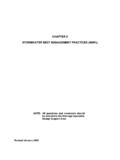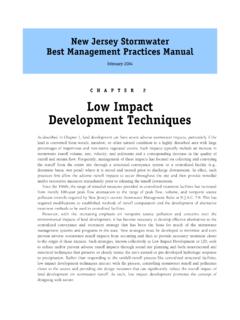Transcription of Best Management Practices and Grease Control …
1 best Management Practices and Grease Control Device Maintenance for Food Service Establishment Employees OBJECTIVE Fully understand how using kitchen best Management Practices (BMPs) to Control Fats, Oils, and Grease (FOG) can prevent sewer blockages and Sanitary Sewer Overflows. Be able to properly clean and maintain a Grease Control device up to 50 GPM (100 lb). Understand background and purpose for the FOG Program. Understand the responsibility of the FSE for preventing illicit FOG discharge. Three (3) year certification with the Regional FOG program. WHAT IS FOG? Fats, Oils, and Grease Any combination of animal fats and/or vegetable oils that are used to prepare food, or are found in food. THE FOG When discharged into sewer lines, FOG and other substances accumulate, solidify, and stick to pipe walls causing blockages and backups in the sanitary sewer system.
2 Significant sources of FOG are residential homes and Food Service Establishments (FSEs), where cooking oil and residual food Grease from dishes are improperly disposed of in drains. THE FOG City-Owned Sanitary Sewer System Food Service Establishment City-owned Stormwater Sewer System BACKGROUND Federal and state mandates require the prevention of Sanitary Sewer Overflows (SSOs). Violations can result in civil penalties. Special Orders of Consent were entered into between the Virginia DEQ, HRSD and area localities to resolve SSOs. Prohibited discharge of Fats, Oils and Grease (FOG) causes or significantly contributes to 2/3 of all SSOs within the region. Management , Operations and Maintenance (MOM) Program established to efficiently resolve SSOs.
3 FOG Program developed within MOM to monitor and regulate FOG waste. Food Service Establishments (FSEs) and Grease Hauler training programs established to inform and train FSE employees, and Hauler owner/operators. The FOG Ordinance is one measure providing adequate regulation to enforce maintenance of Grease Control devices. FOG PROGRAM OBJECTIVES Reduce FOG-related Sanitary Sewer Overflows Provide increased education and awareness of FOG and improve FOG remediation efforts at Food Service Establishments FOG discharge and related SSOs are NO accident! THE HUMAN EXAMPLE Sanitary Sewer System = Human Body Sewer Pipe Network = Arteries Pump Stations = Heart Wastewater Treatment Plant = Kidneys Wastewater Treatment Plant Pump Station Food Service Establishments Sewer Pipe Network THE HUMAN EXAMPLE FOG flows through the sanitary sewer system much like bad cholesterol and fatty acids in the human body (causing hardening of arteries ) FOG can accumulate and constrict flow and potentially cause blockages similar to plaque build up in blood vessels.
4 THE HUMAN EXAMPLE Just like the human body, the best way to prevent FOG buildup is to avoid introducing FOG into the sanitary sewer system. Kitchen BMPs used everyday can significantly reduce FOG buildup. BMPs are like diet and exercise for the sanitary sewer system, replacing bad habits with good. Sanitary Sewer Overflows that result from FOG discharge are violations of state and federal law. There are civil penalties associated with these violations. Fatty Foods Cooking Oils Residual Food Debris Kitchen Utensils Dinnerware Deep Fryers Leftovers Dairy Products Batters, Icing UNDERSTANDING FOG SOURCES FSEs primarily Brown Grease Yellow Grease Even though all Grease has the same effect when discharged into the sanitary sewer system, maintenance measures may vary depending on the different types of FOG generated.
5 Separate yellow and brown Grease disposal is required. UNDERSTANDING FOG SOURCES FOG discharge and related SSOs are NO accident! Illicit FOG discharge causes hardening of arteries for the sanitary sewer system. Kitchen best Management Practices (BMPs) act as diet and exercise for the sanitary sewer system. FOG is generated by various sources from within the FSE. IMPORTANT TAKE AWAY POINTS Use Kitchen best Management Practices for Fats, Oils, and Grease REDUCING FOG FROM FSEs Post No Grease Signs Over Sinks REDUCING FOG FROM FSEs Scrape food from dirty dishes, pots, and pans into a trash can, then dry-wipe them with a paper towel. FOG should not be discarded into garbage disposals. Clean and maintain kitchen fixtures regularly or as required to Control FOG buildup.
6 REDUCING FOG FROM FSEs Use the smallest quantity of chemicals and soap possible to maintain a sanitary kitchen. Too much use of a cleaning product can allow the FOG to pass beyond Grease traps and interceptors. Additives should not be used as Grease Management Control and shall not be substituted for the regular, proper maintenance of Grease Control devices. REDUCING FOG FROM FSEs Food Service Establishment REDUCING FOG FROM FSEs City-Owned Sanitary Sewer System City-Owned Stormwater Sewer System Put yellow Grease in a Grease recycling bin, usually located outside the food service establishment. Keep the lid on the Grease bin closed so that rainwater does not get in. Spills or overflows from FOG containers and dumpsters are extremely damaging to the stormwater system and harmful to the environment.
7 NEVER pour or dispose of Grease , oil, food debris, or trash into a Grease Control device! REDUCING FOG FROM FSEs Call the company that is responsible for removing the Grease and ask them to empty the bin before the receptacle is full. Ensure the recycling bin is in good working order. NEVER pour or dispose of FOG, food debris, or trash into the stormwater system! Clean kitchen floor mats inside over a mop sink or a utility sink. REDUCING FOG FROM FSEs Grease Control Devices (GCDs) are the Last line of Defense against illicit FOG discharge. Install, register, and regularly maintain Grease traps and interceptors. A properly installed and maintained GCD keeps wastewater from backing up and overflowing into the FSE and also keeps FOG from damaging the sanitary sewer system.
8 Grease Control DEVICES Most Grease interceptors are located outside of the FSE, underground. A Grease hauler must be hired to clean a Grease interceptor. If possible, watch the Grease hauler to make sure that the interceptor is completely cleaned and free of FOG buildup. The entire contents of the interceptor must be removed and no water can be decanted back into the interceptor. Grease INTERCEPTORS Grease traps are generally located underneath sinks. FSE employees may clean Grease traps. Grease Control Devices over 50 GPM (100 lb) in size must be cleaned by an approved Grease hauler in most localities. Grease TRAPS Grease TRAP CLEANING Baffles Fixture for food debris A large trash can Two or three trash can liners/bags (heavy duty) or sealable containers Absorbent material (floor dry or clay kitty litter) Proper hand tools and safety equipment for opening trap (allen wrench, screw driver, rubber gloves, etc.)
9 Tools for removing contents: Scoop for water and solids Scraper (putty knife) Wet/dry vacuum Clean paper towels or cloth rags Grease TRAP CLEANING TOOLS & MATERIALS Develop strict maintenance schedule and adhere to it Prepare work area Line trash can with garbage bags Add absorbent material into lined trash can Refer to installation manual for disassembly of the unit Grease TRAP CLEANING BEFORE YOU BEGIN Carefully remove lid without damaging gasket Observe installation of internal parts to ensure proper reinstallation after cleaning Remove ALL contents of trap (by scooping and vacuuming the waste products) until Grease trap is empty Do NOT use hot water, degreasers, or soaps to clean interior of trap Scrape all inside walls, baffles, and screens Inspect and note condition of tank, baffle, and all removable parts (schedule repairs or replacement as needed) Grease TRAP CLEANING STEP BY STEP Make sure Grease trap is properly reassembled Examine the gasket for damage (replace if necessary) Clean and reinstall rubber gasket and reposition lid on tank, ensuring screws are properly tightened Ensure enough absorbent material has been placed in bag to soak up all excess liquids Tie the bag and place in garbage (solid waste) dumpster or designated receptacle.
10 It is ILLEGAL to dump Grease trap or kitchen waste into the sanitary sewer system (toilets, cleanouts, manholes, etc.), storm drains, ponds, or outdoor areas. Grease TRAP CLEANING STEP BY STEP Schedule A Grease trap should be cleaned out completely when about a quarter (25%) of its volume is FOG and solids (floatable and settled materials). The Grease trap should be checked every day to make sure it does not need to be cleaned, and it must be cleaned a minimum of once per week. Grease TRAP CLEANING Maintenance Logs After cleaning out a Grease trap, remember to enter the information into the GCD maintenance log. If a Grease hauler cleaned out the trap or interceptor, put the Grease hauler s manifest into the maintenance log.




